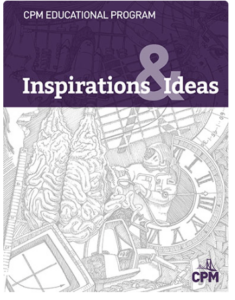
Inspirations & Ideas is designed to support students in CPM’s Core Connections, Course 3 who sometimes struggle with mathematics. The expectation is that students in Inspirations & Ideas will be concurrently enrolled in Core Connections, Course 3, and therefore will have two math classes daily. Ideally, Inspirations & Ideas is a non-graded course, with no homework, and no summative assessments.
Inspirations & Ideas is a compilation of lessons, arranged appropriately in units, that convey multiple objectives. Although each unit may not fully address a single objective, as a compilation the objectives are met. The course does not attempt to address every content standard in the 8th grade curriculum. Rather the math content in the course is used as a vehicle to change students’ beliefs and attitudes about math. Inspirations & Ideas focuses on the following themes:
Incorrect ideas are often necessary to develop correct ideas.
Mathematics is visual.
Effective communication in mathematics should be practiced.
Problem solving strategies make problems accessible.
Building relationships is vital to a positive classroom environment.
Students can re-engage with mathematics in new ways.
New teachers of Inspirations & Ideas must attend the virtual professional learning event. Teachers will need to successfully complete the learning in order to use the curriculum. View Event dates and locations.
I love doing the progress checks with my group!!! It makes me take a step back from groups and lets me observe what is happening and most important gives me the opportunity to check in with my kids. When I asked them, “What is something that is going well for them?” All of them said, “Math this year!” It was so nice hearing this student after student!
I think one of the most striking changes I have seen with the use of the CPM intervention course is the teacher’s awareness of engagement, mindset, and student motivation in their non-intervention classrooms. They are now actively thinking about what actions to take with a student that is suffering from Math apathy, rather than just chalking it up to the new societal norms and moving on.
My favorite thing about this math class is doing the activities because I am more of a hands on learner and I learn more when I do activities that involve me working with stuff and my grades have improved ever since we have done this course.
This class helps with my regular math class, and I went up on my school’s benchmarks, and I feel more confident in my math class.
This is usually my favorite part of my day! Maybe because it is all new and a challenge for me but I always look forward to seeing where we are headed and the growth my students are making.
I want to integrate a lot of this into my regular courses. Most of the lessons are highly engaging and it is really fun to watch students excel when typically they don't.
I really enjoy teaching this class and seeing the accomplishments of my students. I can see the confidence growing in each of them and it is really exciting!

I love teaching a math intervention group of students using a curriculum that is high interest and high engagement. All the other programs out on the market are low engagement and low level questions.

I am seeing a change in the mindset of students whose past teachers have said, “You can try but they just will not put forth any effort.” These students are the ones saying things like, “Well, I was thinking…” and I rarely hear “I can't” anymore!

This professional learning is designed for teachers as they begin their implementation of CPM. This series contains multiple components and is grounded in multiple active experiences delivered over the first year. This learning experience will encourage teachers to adjust their instructional practices, expand their content knowledge, and challenge their beliefs about teaching and learning. Teachers and leaders will gain first-hand experience with CPM with emphasis on what they will be teaching. Throughout this series educators will experience the mathematics, consider instructional practices, and learn about the classroom environment necessary for a successful implementation of CPM curriculum resources.
Page 2 of the Professional Learning Progression (PDF) describes all of the components of this learning event and the additional support available. Teachers new to a course, but have previously attended Foundations for Implementation, can choose to engage in the course Content Modules in the Professional Learning Portal rather than attending the entire series of learning events again.
The Building on Instructional Practice Series consists of three different events – Building on Discourse, Building on Assessment, Building on Equity – that are designed for teachers with a minimum of one year of experience teaching with CPM instructional materials and who have completed the Foundations for Implementation Series.
In Building on Equity, participants will learn how to include equitable practices in their classroom and support traditionally underserved students in becoming leaders of their own learning. Essential questions include: How do I shift dependent learners into independent learners? How does my own math identity and cultural background impact my classroom? The focus of day one is equitable classroom culture. Participants will reflect on how their math identity and mindsets impact student learning. They will begin working on a plan for Chapter 1 that creates an equitable classroom culture. The focus of day two and three is implementing equitable tasks. Participants will develop their use of the 5 Practices for Orchestrating Meaningful Mathematical Discussions and curate strategies for supporting all students in becoming leaders of their own learning. Participants will use an equity lens to reflect on and revise their Chapter 1 lesson plans.
In Building on Assessment, participants will apply assessment research and develop methods to provide feedback to students and inform equitable assessment decisions. On day one, participants will align assessment practices with learning progressions and the principle of mastery over time as well as write assessment items. During day two, participants will develop rubrics, explore alternate types of assessment, and plan for implementation that supports student ownership. On the third day, participants will develop strategies to monitor progress and provide evidence of proficiency with identified mathematics content and practices. Participants will develop assessment action plans that will encourage continued collaboration within their learning community.
In Building on Discourse, participants will improve their ability to facilitate meaningful mathematical discourse. This learning experience will encourage participants to adjust their instructional practices in the areas of sharing math authority, developing independent learners, and the creation of equitable classroom environments. Participants will plan for student learning by using teaching practices such as posing purposeful questioning, supporting productive struggle, and facilitating meaningful mathematical discourse. In doing so, participants learn to support students collaboratively engaged with rich tasks with all elements of the Effective Mathematics Teaching Practices incorporated through intentional and reflective planning.